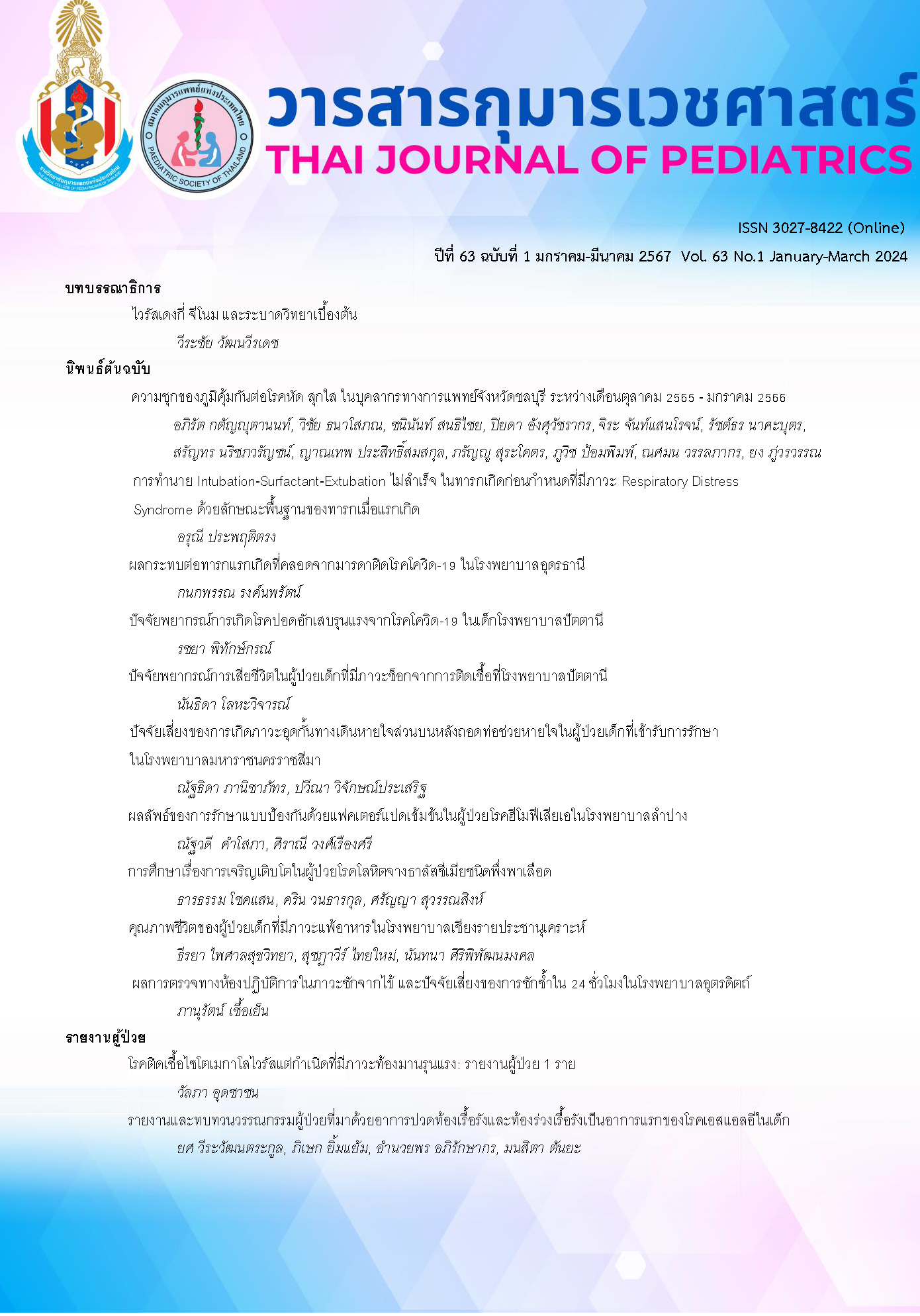ปัจจัยเสี่ยงของการเกิดภาวะอุดกั้นทางเดินหายใจส่วนบนหลังถอดท่อช่วยหายใจ ผู้ป่วยเด็กที่เข้ารับการรักษาในโรงพยาบาลมหาราชนครราชสีมา
คำสำคัญ:
ท่อช่วยหายใจ , ภาวะแทรกซ้อน, เด็กบทคัดย่อ
ความเป็นมา: ภาวะอุดกั้นทางเดินหายใจส่วนบนหลังถอดท่อช่วยหายใจ เป็นภาวะแทรกซ้อนที่อาจเกิดขึ้นทันทีหลังถอดท่อช่วยหายใจ เป็นสาเหตุที่ทำให้การถอดท่อช่วยหายใจล้มเหลว นำไปสู่การใส่ท่อช่วยหายใจซ้ำ เพิ่มโอกาสการเกิดปอดติดเชื้อ ทำให้มีระยะเวลานอนโรงพยาบาล และอัตราตายที่มากขึ้น แต่ในประเทศไทยยังมีการศึกษาเรื่องปัจจัยเสี่ยงที่สัมพันธ์กับการเกิดภาวะอุดกั้นทางเดินหายใจส่วนบนหลังถอดท่อช่วยหายใจในเด็กน้อย
วัตถุประสงค์: ศึกษาปัจจัยเสี่ยงที่สัมพันธ์กับการเกิดภาวะอุดกั้นทางเดินหายใจส่วนบนหลังถอดท่อช่วยหายใจในผู้ป่วยที่เข้ารับการรักษาในหอผู้ป่วยวิกฤตเด็ก โรงพยาบาลมหาราชนครราชสีมา
วิธีการศึกษา: เป็นรูปแบบการศึกษาแบบไปข้างหน้า โดยผู้ป่วยอายุตั้งแต่ 29 วัน ถึง 15 ปี ที่เข้ารับการรักษาที่หอผู้ป่วยวิกฤตเด็ก โรงพยาบาลมหาราชนครราชสีมา ตั้งแต่วันที่ 1 มกราคม ถึง 30 พฤศจิกายน 2563 และใส่ท่อช่วยหายใจอย่างน้อย 12 ชั่วโมง พร้อมทั้งได้รับการถอดท่อช่วยหายใจในหอผู้ป่วยวิกฤตเด็ก โดยเก็บข้อมูล เช่น ชนิดของท่อช่วยหายใจ ยาสลบที่ใช้ระหว่างการใส่ท่อช่วยหายใจ ระยะเวลาการใส่ท่อช่วยหายใจ จนกระทั่งถอดท่อช่วยหายใจและติตตามการเกิดภาวะอุดกั้นทางเดินหายใจส่วนบนหลังถอดท่อช่วยหายใจจนกว่าผู้ป่วยจะกลับบ้านหรือเสียชีวิต และนำข้อมูลมาวิเคราะห์ด้วย multiple logistic regression
ผลการศึกษา: มีผู้ป่วยเข้ารับการรักษาในหอผู้ป่วยวิกฤตเด็กจำนวน 386 ราย เข้าเกณฑ์การศึกษา 251 ราย คัดผู้ป่วยตามเกณฑ์การคัดออก เหลือผู้ป่วยเข้าการศึกษาทั้งหมด 134 ราย โดยเป็นเพศชาย 82 ราย (ร้อยละ 61.2) อายุมัธยฐาน 1 ปี 9 เดือน มีโรคประจำตัว 62 ราย (ร้อยละ 46.3) ข้อบ่งชี้ที่เข้ารับการรักษาในหอผู้ป่วยวิกฤตเด็ก ได้แก่ ข้อบ่งชี้ทางคลินิก 104 ราย (ร้อยละ 77.6) และข้อบ่งชี้ทางการผ่าตัด 30 ราย (ร้อยละ 22.4) พบอัตราการเกิดภาวะอุดกั้นทางเดินหายใจส่วนบนหลังถอดท่อช่วยหายใจร้อยละ 37.3 โดยปัจจัยที่มีความสัมพันธ์กับการเกิดภาวะอุดกั้นทางเดินหายใจส่วนบนหลังถอดท่อช่วยหายใจ ได้แก่ อายุของผู้ป่วยที่มากขึ้น มีโอกาสเกิดภาวะอุดกั้นทางเดินหายใจส่วนบนหลังถอดท่อช่วยหายใจลดลง (OR 0.81, 95%CI 0.68-0.95, p value 0.01) และขนาดของท่อช่วยหายใจ โดยกลุ่มที่ใส่ท่อช่วยหายใจขนาดเล็ก และขนาดใหญ่กว่าที่ควรจะเป็น มีโอกาสเกิดภาวะอุดกั้นทางเดินหายใจส่วนบนหลังถอดท่อช่วยหายใจมากกว่ากลุ่มที่ใส่ท่อช่วยหายใจขนาดเหมาะสม เป็น 7.6 เท่า (OR 7.6, 95%CI 2.23-25.59, p value <0.01) และ 10.4 เท่า (OR 10.4, 95%CI 2.4-44.81, p-value <0.01) ตามลำดับ
สรุป: ผู้ป่วยที่เข้ารับการรักษาในหอผู้ป่วยวิกฤตเด็ก โรงพยาบาลมหาราชนครราชสีมา มีอัตราการเกิดภาวะอุดกั้นทางเดินหายในส่วนบนหลังถอดท่อช่วยหายใจร้อยละ 37.3 ปัจจัยที่มีผลต่อการเกิดภาวะอุดกั้นทางเดินหายใจส่วนบนหลังถอดท่อช่วยหายใจได้แก่ อายุน้อย และขนาดของท่อช่วยหายใจที่ไม่เหมาะสมกับอายุ
Downloads
เอกสารอ้างอิง
Prasertsan P, Nakju D, Lertbunrian R, Chantra M, Anantasit N. Nebulized fluticasone for preventing postextubation stridor in intubated children: A randomized, double-blind placebo-controlled trial. Pediatr Crit Care Med. 2017;18:e201-6.
Kurachek SC, Newth CJ, Quasney MW, Rice T, Sachdeva RC, Patel NR, et al. Extubation failure in pediatric intensive care: A multiple-center study of risk factors and outcomes. Crit Care Med. 2003;31:2657-64.
Nascimento MS, Prado C, Troster EJ, Valero N, Alith MB, Almeida JF. Risk factors for post-extubation stridor in children: The role of orotracheal cannula. Einstein. 2015;13:226-31.
Laham JL, Breheny PJ, Rush A. Do clinical parameters predict first planned extubation outcome in the pediatric intensive care unit. J Intensive Care Med. 2015;30:89-96.
Saleem AF, Bano S, Haque A. Does prophylactic use of dexamethasone have a role in reducing post extubation stridor and reintubation in children? Indian J Pediatr. 2009;76:555-7.
Baranwal AK, Meena JP, Singhi SC, Muralidharan J. Dexamethasone pretreatment for 24 h versus 6 h for prevention of postextubation airway obstruction in children: A randomized double-blind trial. Intensive Care Med. 2014;40:1285-94.
Sathyamoorthy M, Lerman J, Asariparampil R, Penman AD, Lakshminrusimha S. Stridor in neonates after using the Microcuff and uncuffed tracheal tubes: A retrospective review. Anesth Analg. 2015;121:1321-4.
Green J, Walters HL, Delius RE, Sarnaik A, Mastropietro CW. Prevalence and risk factors for upper airway obstruction after pediatric cardiac surgery. J Pediatr. 2015;166:332-7.
Khemani RG, Hotz J, Morzov R, Flink R, Kamerkar A, Ross PA, et al. Evaluating risk factors for pediatric post-extubation upper airway obstruction using a physiology-based tool. Am J Respir Crit Care Med. 2016;193:198–209.
Schweiger C, Eneas LV, Manica D, Netto CSS, Carvalho PRA, Piva JP, et al. Accuracy of stridor-based diagnosis of post-intubation subglottic stenosis in pediatric patients. J Pediatr. (Rio J) 2020;96:39-45
Cordeiro AM, Fernandes JC, Troster EJ. Possible risk factors associated with moderate or severe airway injuries in children who underwent endotracheal intubation. Pediatr Crit Care Med. 2004;5:364-8.
Kemper KJ, Benson MS, Bishop MJ. Predictors of postextubation stridor in pediatric trauma patients. Crit Care Med. 1991;19:352-5.
Smith MM, Kuhl G, Carvalho PR, Marostica PJ. Flexible fiber-optic laryngoscopy in the first hours after extubation for the evaluation of laryngeal lesions due to intubation in the pediatric intensive care unit. Int J Pediatr Otorhinolaryngol. 2007;71:1423-8.
Sample size for a cohort study [Internet]. EpiTools. [Cited 1 Nov 2019]. Available from: http://epitools.ausvet.com.au/content.php?page=cohortSS
ดาวน์โหลด
เผยแพร่แล้ว
รูปแบบการอ้างอิง
ฉบับ
ประเภทบทความ
สัญญาอนุญาต
ลิขสิทธิ์ (c) 2024 ราชวิทยาลัยกุมารแพทย์แห่งประเทศไทย และ สมาคมกุมารแพทย์แห่งประเทศไทย

อนุญาตภายใต้เงื่อนไข Creative Commons Attribution-NonCommercial-NoDerivatives 4.0 International License.



